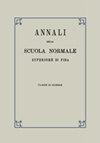Damek-Ricci空间上无穷远处的度规
IF 1.2
2区 数学
Q1 MATHEMATICS
Annali Della Scuola Normale Superiore Di Pisa-Classe Di Scienze
Pub Date : 2019-01-01
DOI:10.2422/2036-2145.201801_001
引用次数: 0
摘要
设S = A为Damek-Ricci空间,通过Cayley变换与S中的单位球B识别。让S p + q = @B单位球的年代,p =昏暗的v, q =昏暗的z。球模型计算的指标[1]在欧几里得(或测地线)极坐标和在笛卡尔坐标b上的感应度规欧几里得球体半径为R的年代(R)是一个常曲率项的总和,加上一个修正项比例h1, h1是一个合适的微分表达式顺利在S (R) R < 1,但是就会(可能)单数单位球上的杆(0,0,1).它有一个简单的几何解释,即h1 = |2|2,其中2在保形因子范围内,是正则1-形式在群N(定义N上的水平分布)上的广义立体投影的回拉。在对称情况下h1,以及S p+q \{(0,0,1)}上的输运分布,对整个球面有光滑的扩展。这可以用S p+q的霍普夫振动来解释。在一般情况下,在单位球上不允许有这样的结构,在[1]中,h1在极点处是否平滑延伸的问题是开放的。本文证明了除对称情况外,h1不扩展。更准确地说,将(V, Z)坐标下的h1在S p+q上写成h1 = p h i j dzi dz j + p h i j dvi dv j + p h i j dzi dv j,我们证明了,在非对称情况下,系数h i j在极点处没有极限,在极点处保持有界,而系数h i j和h (zv) i j在极点处平滑扩展。为了做到这一点,我们得到了对任何Damek-Ricci空间有效的1-form - 2的显式公式。从这个公式我们推断出,除了q = 1(厄米对称情况),2不能扩展到极点。2的平方和分布ker2不会扩展,除非S是对称的。事实上,我们证明了h1的奇异部分当且仅当j2条件成立时完全消失。数学学科分类(2010):22E25(初级);43A85, 53C30(二级)。本文章由计算机程序翻译,如有差异,请以英文原文为准。
The metric at infinity on Damek-Ricci spaces
Let S = N A be a Damek-Ricci space, identified with the unit ball B in s via the Cayley transform. Let S p+q = @B be the unit sphere in s, p = dim v, q = dim z. The metric in the ball model was computed in [1] both in Euclidean (or geodesic) polar coordinates and in Cartesian coordinates on B. The induced metric on the Euclidean sphere S(R) of radius R is the sum of a constant curvature term, plus a correction term proportional to h1, where h1 is a suitable differential expression which is smooth on S(R) for R < 1, but becomes (possibly) singular on the unit sphere at the pole (0, 0, 1). It has a simple geometric interpretation, namely h1 = |2|2, where 2 is, up to a conformal factor, the pull-back of the canonical 1-form on the group N (defining the horizontal distribution on N ) by the generalized stereographic projection. In the symmetric case h1, as well as the transported distribution on S p+q \ {(0, 0, 1)}, have a smooth extension to the whole sphere. This can be interpreted by the Hopf fibration of S p+q . In the general case no such structure is allowed on the unit sphere, and the question was left open in [1] whether or not h1 extends smoothly at the pole. In this paper we prove that h1 does not extend, except in the symmetric case. More precisely, writing h1 in the coordinates (V, Z) on S p+q as h1 = P h i j dzi dz j + P h i j dvi dv j + P h i j dzi dv j , we prove that, in the non-symmetric case, the coefficients h i j do not have a limit at the pole, but remain bounded there, whereas the coefficients h i j and h (zv) i j extend smoothly at the pole. In order to do this, we obtain an explicit formula for the 1-form 2 valid for any Damek-Ricci space. From this formula we deduce that2 does not extend to the pole, except for q = 1 (Hermitian symmetric case). The square of 2 and the distribution ker2 do not extend, unless S is symmetric. Indeed, we prove that the singular part of h1 vanishes identically if and only if the J2-condition holds. Mathematics Subject Classification (2010): 22E25 (primary); 43A85, 53C30 (secondary).
求助全文
通过发布文献求助,成功后即可免费获取论文全文。
去求助
来源期刊
CiteScore
2.30
自引率
0.00%
发文量
90
审稿时长
>12 weeks
期刊介绍:
The Annals of the Normale Superiore di Pisa, Science Class, publishes papers that contribute to the development of Mathematics both from the theoretical and the applied point of view. Research papers or papers of expository type are considered for publication.
The Annals of the Normale Scuola di Pisa - Science Class is published quarterly
Soft cover, 17x24

 求助内容:
求助内容: 应助结果提醒方式:
应助结果提醒方式:


